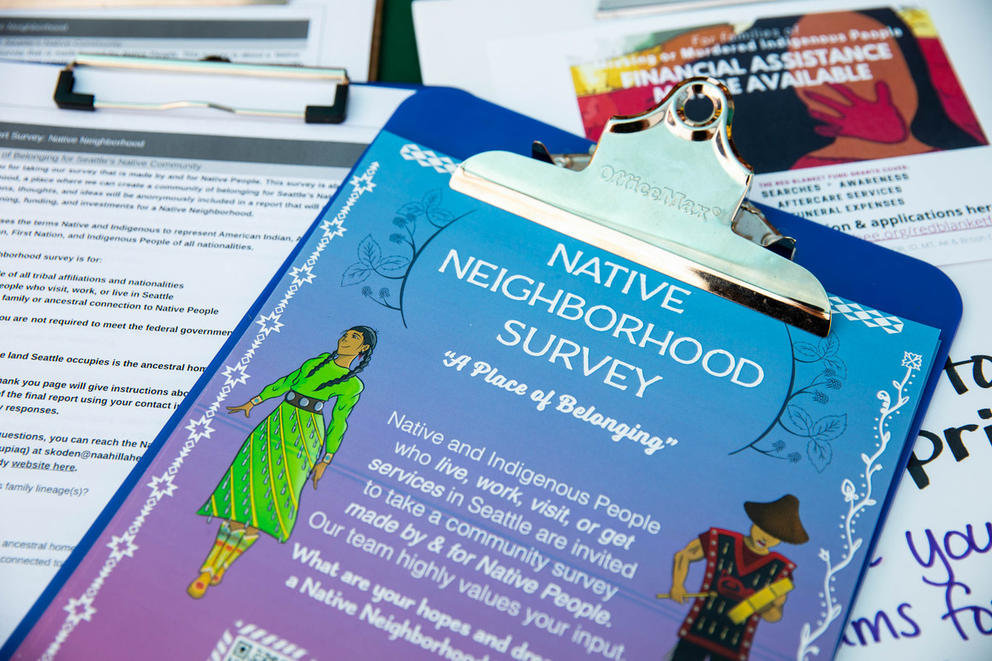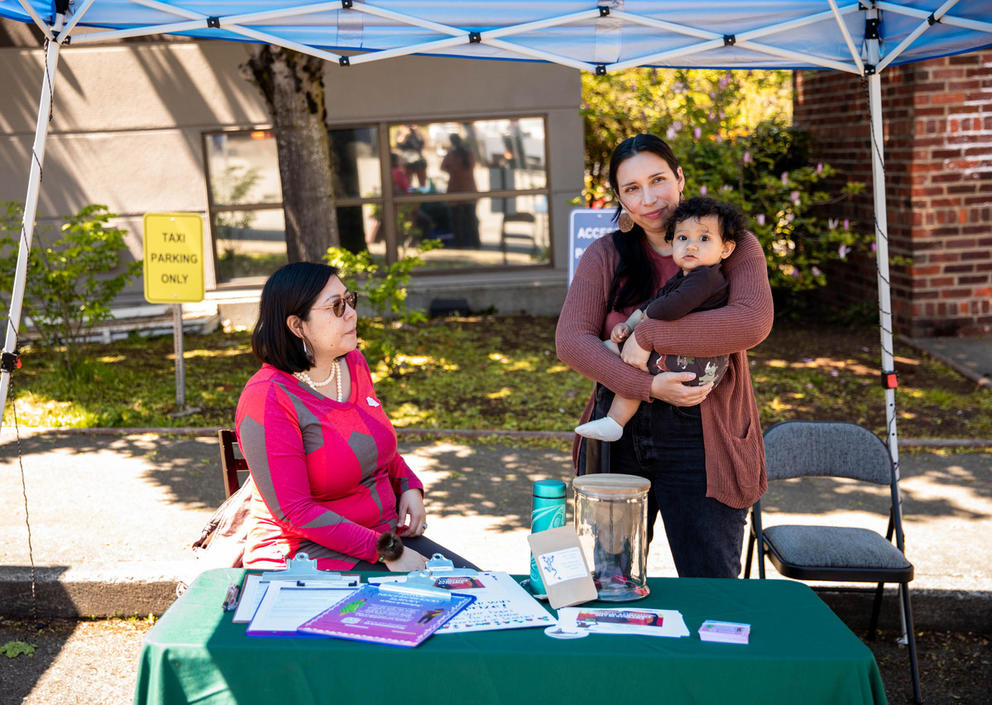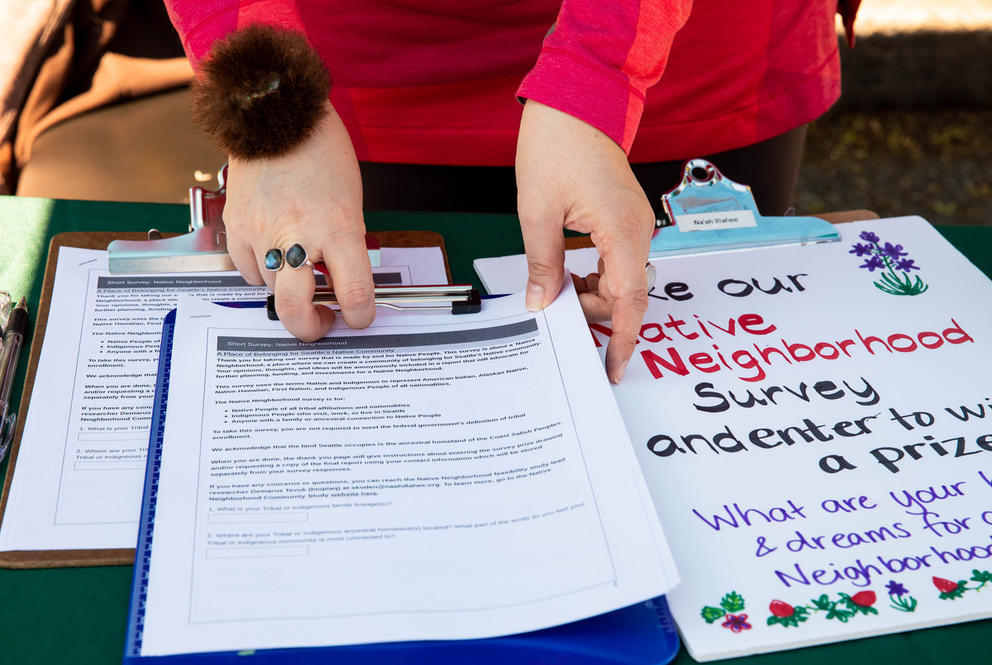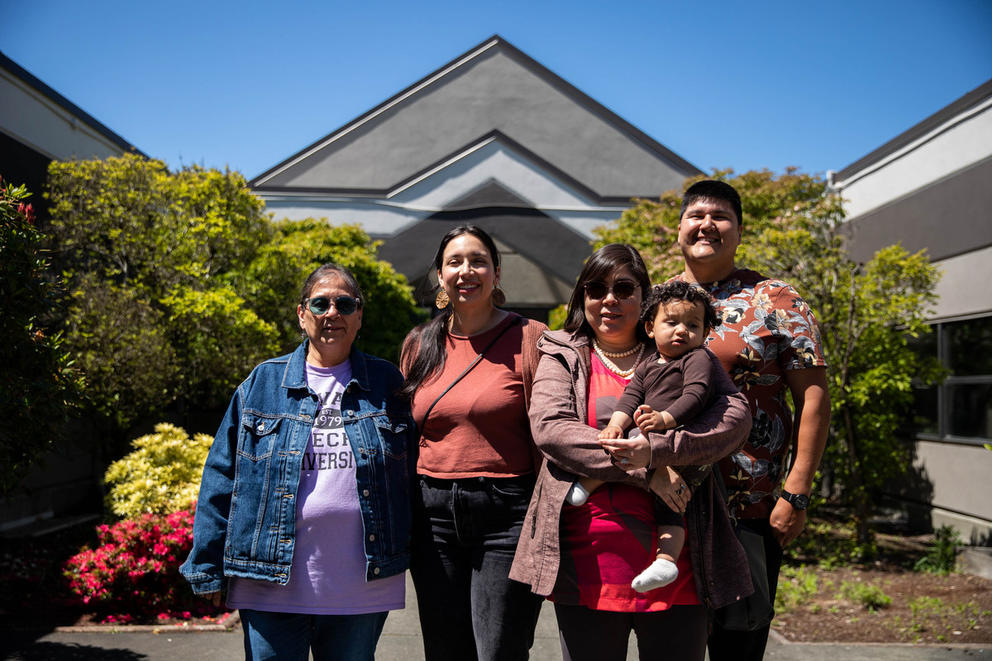Demarus Tevuk, an Inupiaq researcher, was contracted by the Na’ah Illahee Fund to conduct a survey that would help determine what a neighborhood for Seattle's urban Native community would consist of and if such a cultural hub was even wanted. The responses have been overwhelmingly in favor.
“A lot of us have been displaced from our homelands or people, having a place(s) to be Native would help foster community, reinforce identity and provide healing for our people,” an anonymous survey respondent wrote.
According to survey responses, even many Native people who grew up in Seattle don’t know where to go to connect with other Native people in the city. Survey respondents shared a resounding feeling of seclusion, loneliness and being underserved.
Racist assimilation policies
Native people were displaced to urban cities during the mid-20th century by racist policies like the Indian Termination Act, in which Congress terminated many federally recognized tribes' status and sold their land. Without recognition or a reservation, the tribes lost federal funding for their schools, hospitals and other community services. The Indian Relocation Act pushed Native people to relocate to urban centers with the promise of jobs, housing, education and the social services no longer available on their traditional homelands.
Those empty promises left Indigenous people homeless and alone in major cities, which had no knowledge about how to best support them.
“We'd get Native people off the Greyhound bus because back then it was like just three or four blocks from Seattle Indian Health Center, but they would walk in thinking they could get a house that day,” said Denise Emerson, who is Navajo, Skokomish and Duwamish. Emerson worked with the Seattle Indian Health Center social services program in the late 1970s. “It was heartbreaking to watch and listen to people as they came in. They didn't have luggage. They just had what they had when they got off the bus.”
From the 1950s to the 1980s, hundreds of thousands of Indigenous people relocated to urban centers, from Chicago to Denver to Seattle, according to the National Archives. Now, more than 70% of Indigenous people live in urban areas with no access to resources that are available to Native people living on reservations.
Demarus Tevuk and Kimberly Kimberly Deriana, with her child, Khalako Lloyd, sit at their table at the Indigenous Vendors Market outside the Seattle Indian Health Board on May 21, 2022. They’re part of a coalition that has been envisioning a Native neighborhood where Native people feel a sense of community and of belonging. (Amanda Snyder/Crosscut)
A new kind of neighborhood
Emerson, now a beader and graphic designer, works with Tevuk, the Inupiaq researcher, to create graphics for the final report of the Na’ah Illahee Funds survey. Tevuk collaborated with a coalition for guidance and input on the survey questions. The group included sləp̓iləbəxʷ (meaning Rising Tides in Lushootseed); Francesca Murnan, the Indigenous Advisory Council liaison, who is Shawnee and Cherokee; the Seattle Indian Health Board; and Lindsey Goes Behind, who is from the Alabama-Coushatta Tribe of Texas and an equitable development initiative board member, as well as the previous managing director at Na’ah Illahee Fund, who now works at the Chief Seattle Club.
The survey attracted 469 responses through paper or online versions, one-on-one meetings, a group talking circle meeting, and focus groups. The coalition will continue to collect input until June 13.
Affordable housing, education and health care were the highest priorities for people who have responded to the survey so far. That parallels the services promised but not delivered nearly 70 years ago in federal relocation policies.
Goes Behind was inspired by urban Natives in Minneapolis, who created Little Earth in 1973 to provide services for and combat assimilation of people from 38 separate Native nations who were forcibly relocated to the Twin Cities.
“A lot of our people couldn't find safe and stable housing once they got here. Little Earth came about in response to that, so that we would be able to have a safe place to live,” said Joe Bealieu, Red Lake Band of Ojibwe and the executive director of Little Earth. Little Earth inspired the initial idea and survey for a Native neighborhood in Seattle.
Little Earth remains the only Section 8 rental assistance community in the U.S. that’s an Indigenous preference project. Section 8 is a Housing and Urban Development Department voucher program that helps low-income people pay for housing. Much like Chief Seattle Club’s low-income housing project, ?ál?al, Little Earth won’t turn away non-Native people, but to live there your income cannot be above a certain amount to qualify and Indigenous people are prioritized.
“I think [Little Earth] is a good model of empowerment and being able to have Native people together and sharing the beauty of their culture,” Bealieu said.
Today, Little Earth provides everything from workforce development to conflict resolution and financial literacy programs. Its people also have a community farm where members of the Little Earth community harvest traditional food and medicines, as well as learn about diabetes prevention and receive healthy food boxes from the farm.
Culture and creating visibility
Food is central to culture, according to Tevuk. A major takeaway from the talking circle that was part of local research to build something similar in Seattle was the importance of having traditional food options in a Seattle Native neighborhood as well.
The survey also asks people about their ancestral homelands to get a better idea of the diversity of the urban Native population so that the neighborhood can adequately reflect the people and be welcoming to all. This would allow a better understanding of traditional foods, traditions, art and even identity.
Many urban Natives have been disconnected from their cultural identity and traditional homelands, and some are not enrolled in a nation. Tevuk said that is why it is important for all Natives, not just those who are enrolled members of a Native nation, to fill out the survey.
“There's a lot of people who have ancestry, but they're not enrolled and then they don't feel connected but they want to be,” Tevuk said. “I'm hoping that we have a program to help people really, authentically, connect with their culture and their identity in meaningful ways.”
Another takeaway from the survey process is a consensus that educating non-Natives is important. According to Tevuk and survey responses, past policy and how it affects Native identity are nuances that most non-Native people don’t understand and have never had the opportunity to learn. This ignorance has led to stereotypes about addiction and homelessness that are continuously perpetuated, causing further harm, Tevuk said.
Having a Native neighborhood would also add visibility to Native people and their concerns. “There is a Chinatown, Little Saigon and many more. Having a Native Neighborhood would add more visibility, which would showcase a lot of respect to the original peoples of this land,” one anonymous respondent to the survey said.
Bealieu agreed, attesting to what has been experienced at Little Earth: “We are such a small minority in this country, and visibility is such an issue for us. But when we were able to come together and have visibility in Minneapolis, I think we can have a greater impact.”
From left: Denise Emerson, Kimberly Deriana, Demarus Tevuk, holding Khalako Lloyd, and Tim Lehman outside the Seattle Indian Health Board on May 21, 2022. They’re part of a larger group that has been envisioning a Native neighborhood where Native people feel a sense of community and belonging. (Amanda Snyder/Crosscut)
Just the beginning
Building a Native neighborhood that is informed by the urban Native population in a mindful way takes time and resources. The Na’ah Illahee Fund supported Tevuk’s role through a $37,000 grant from the Equitable Development Initiative at Seattle's Office of Planning & Community Development — a grant that will end in July. The original contract was intended only for six months, but the process of building a survey, dispersing it during a pandemic, getting people to share their perspectives, analyzing results and then writing a report has been more than a six-month job.
Tevuk is the only paid employee for this project, and she has worked two other jobs while in this role. All other sləp̓iləbəxʷ group members volunteered their time and insight in creating the survey and getting the word out. Efforts to get responses included having tables at events such as the annual University of Washington Spring Powwow and putting up flyers and posters all around town.
A Social Justice Fund NW grant awarded to the Na'ah Illahee Fund will pay for Tevuk’s work to finalize the report by September.
The report is just the beginning. Next comes a feasibility study to determine how much money would be needed to start building the project. Tevuk believes that at least three full-time paid positions will be needed for this work, but she worries that might not be possible.
“There is a stereotype that people think that we get free money, where we're taken care of because of the treaties and then they don't want to donate,” Tevuk said. “These are issues with philanthropy that are unique to Native communities.”
Tevuk’s concerns aren’t unfounded. According to a report by Seattle Urban Native Nonprofits, less than 1% of philanthropic funds are awarded to Native-led nonprofit organizations, despite Native people being 2% of the population and among communities of greatest need. She also pointed out that many organizations are competing for the same city funding, and philanthropic misconceptions make things even more difficult.
One third of Little Earth’s program funding and most of its staff support comes from the county government. City and state grants also fund the program’s operation, but it has dealt with some of the same misconceptions that Tevuk raised. People assume Little Earth is like a reservation with some federally funding and land, but this is not the case, according to Bealieu.
While Little Earth is not a federally recognized reservation, for the urban Natives who were displaced it feels like the closest thing to traditional living among other Native people that they can get in the middle of the city
“We're not just like a community,” said Latisha Icemen, Red Lake Band of Ojibwe and youth empowerment director of Little Earth. “We're like family.”
The need for community support and the feeling of family was mentioned over and over in the Seattle survey.
“For urban Natives, it’s hard to feel like you belong to a community if you don’t have any family here. You feel very alone,” a survey respondent said. In order to accomplish this, there has to be a foundation of trust that Seattle’s urban Natives can do the work, said Tevuk, who has high hopes that this is just the beginning of something greater.






